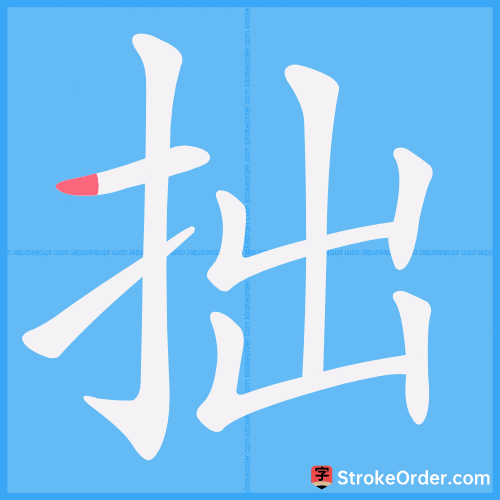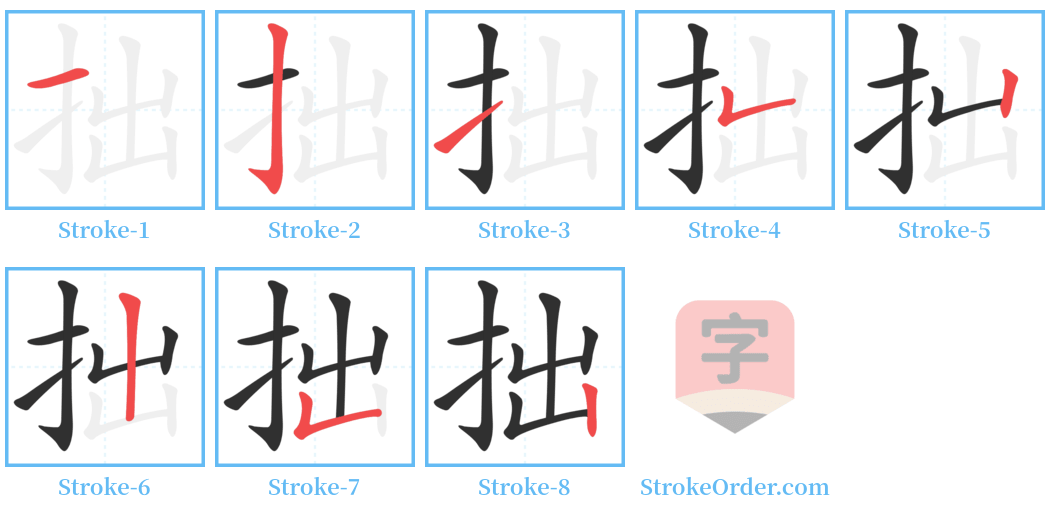拙 Stroke Order
Animated Stroke Order of 拙

Stroke Order Diagrams for 拙

Step-by-Step Handwriting Guide for 拙

Learn to Write Chinese Characters with Video Tutorials
Watch the video of writing the Chinese character "拙", learn the correct stroke order (笔顺) of the character "拙", and master the standard way of writing the character "拙".
Free Printable Handwriting Practice with Stroke Order: 拙
Printable Writing Practice Worksheet of "拙" in Portrait Orientation (Tian Zi Ge)

Printable Writing Practice Worksheet of "拙" in Landscape Orientation (Tian Zi Ge)

Information of 拙
Pinyin
zhuō
Radical
扌
Strokes
8 strokes
Usage
★★★★★
Definition
awkward / clumsy / dull / inelegant / (polite) my
拙 [zhuō]
形
1. 笨,不灵巧。
Clumsy; awkward.
例:笨拙、手拙、弄巧成拙。
(Examples: clumsy, unskilled, making a blunder while attempting cleverness.)
2. 谦辞,称自己的。
Humble expression, used to refer to oneself.
例:拙见、拙作、拙计。
(Examples: my view, my work, my plan.)
3. 古朴的、未加修饰的。
Primitive; unembellished.
例:古拙、朴拙。
(Examples: ancient simplicity, plain and simple.)
---
拙 [zhuō]
动
1. 不善于。
Not good at.
例:拙生(拙于生计,不善谋生)、拙政(拙于为政)。
(Examples: poor at making a living; ineffective in governance.)
2. 穷尽; 用尽。
Exhaust; use up.
例:计拙无衣食,途穷仗友生。
(Example: Expend all resources, relying on friends in times of need.)
3. 屈抑; 粗暴对待。
Rude; treat violently.
例:径省其说,则以为不智而拙之。
(Example: Simplifying the discussion may be deemed unwise and straightforward.)
---
拙
形
1. 笨,不灵巧。如:笨拙、手拙、弄巧成拙。
Clumsy; awkward. Examples: clumsy, unskilled, making a blunder while attempting cleverness.
2. 谦称自己的。如:拙见、拙作、拙计。
Humble expression for oneself. Examples: my view, my work, my plan.
3. 古朴的、未加修饰的。如:古拙、朴拙。
Primitive; unembellished. Examples: ancient simplicity, plain and simple.
Input Method for 拙
Pinyin
zhuo1
Wubi
rbmh
Cangjie
quu
Zhengma
dzzi
Four Corner
52072
Unicode
U+62d9
Same Pronunciation Characters